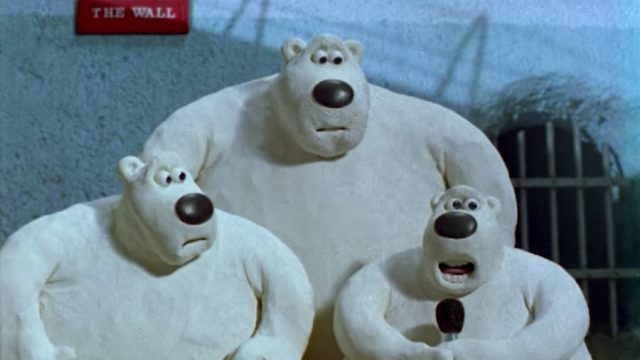Aardman’s masterful run of animated shorts arguably begins here. The British studio has been around since the mid-70s contributing to children’s television but always with an eye on expanding the audience for animation. Their memorable music video work includes the Peter Gabriel classic for “Sledgehammer” as well as Nina Simone’s “My Baby Just Cares For Me” and Robert Parker’s “Barefootin’.”
Even “Creature Comforts” has numerous precedents. In 1982 Aardman produced a series of shorts called Conversation Pieces that animated interview recordings with real people with down-to-earth jobs and concerns like movie ushers, radio station producers, and a door-to-door salesmen. The idea was revived in 1989 for entries in another series titled Lip Sync. Just as before, interviews were conducted with a variety of real-life subjects. But unlike the previous series, the animated characters aren’t always stiff models supported by armatures and nightmares.
The models moved and, importantly, used facial expressions with much more ease and character. Any of the Lip Sync shorts are worthy of Lunch Linking, like the surrealist horror bit “Ident” or the strange Shakespeare tribute “Next.” Two entries besides “Creature Comforts” use an interview soundtrack, both by Aardman co-founder Peter Lord. “Going Equipped” is more the style of the early Conversation Pieces entries, but the best of the lot might be his “War Story,” an ambling recollection by a World War II vet.
But “Creature Comforts” has the magic that would come with soon-to-be-star animator Nick Park. The director who would soon helm some of the best animated shorts of all time in the Wallace and Gromit series is in prime form here. The expressions of the polar bear family reacting to whoever has the mic is previously unknown level of character-based comedy from the other shorts. Adding the microphone for each subject heightens the humor of animals giving responses with human voices. The film is pretty static compared to the dynamism of “War Story,” or really most any other animated fare. For a lauded work of an artform based entirely on motion, “Creature Comforts” is quite restrained. But it makes each crinkle of the brow or flip of the paw count.
“Creature Comforts” would win the Academy Award for animated short that year (beating out Park’s own “A Grand Day Out”). It was the studio’s first time at the Oscars, but it broke the seal and either Park or Lord would score a nomination or win in four of the next six years. Park’s cuddly, comfortable creatures marked the path that lead to success, but also away from many of the adult animation experimentation that marked early Aardman work. Certainly grownups have enjoyed Chicken Run and Shaun the Sheep, but the Western idea of animation as medium that has to appeal to children first has remained obdurate.

